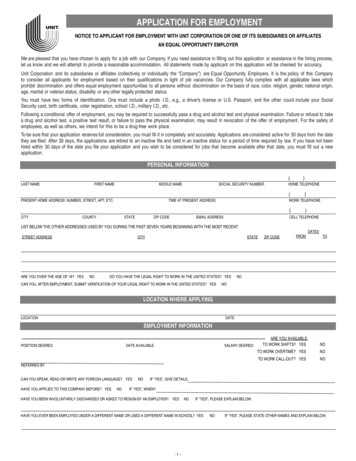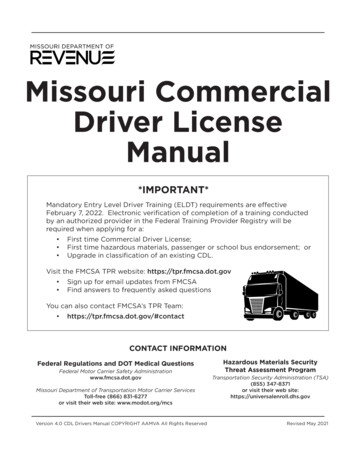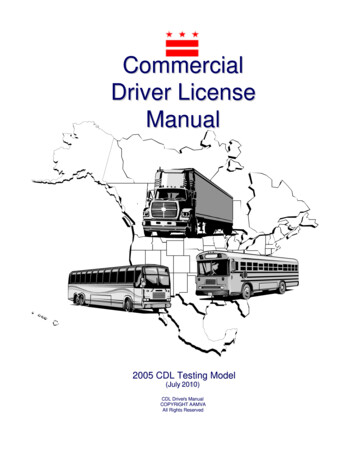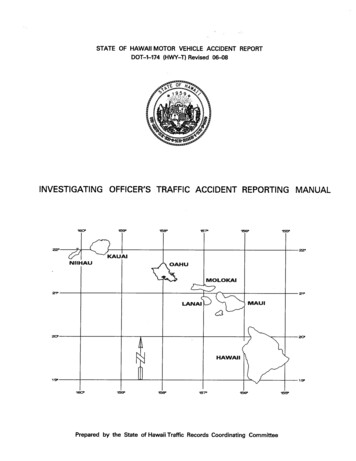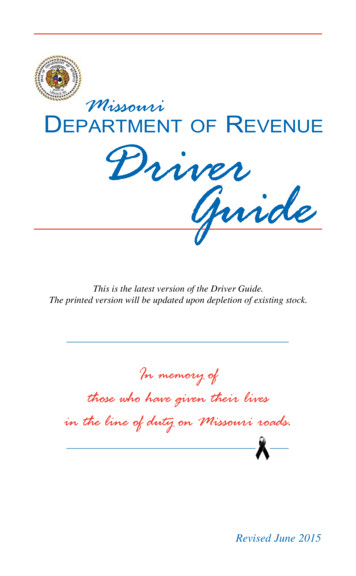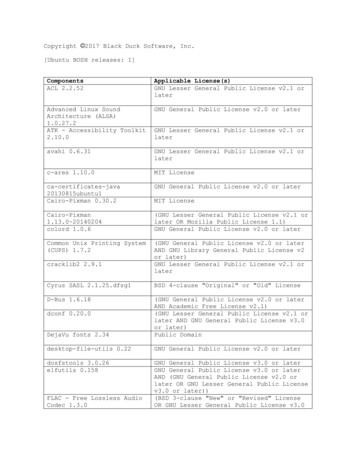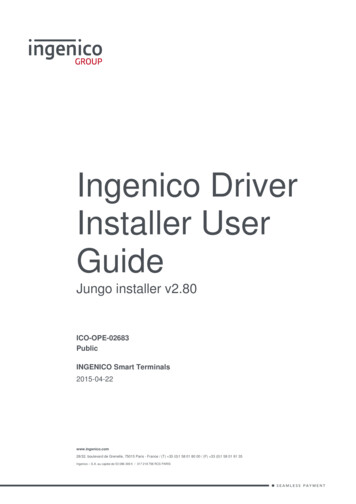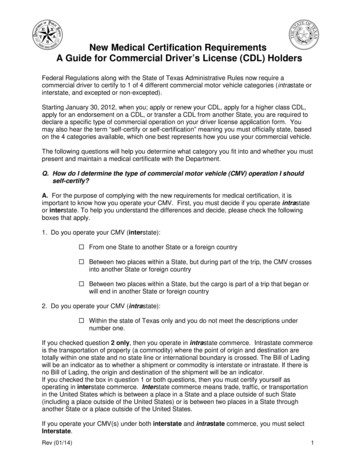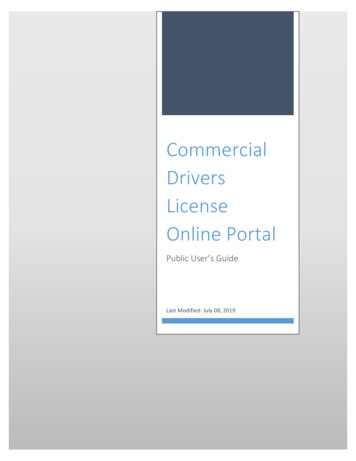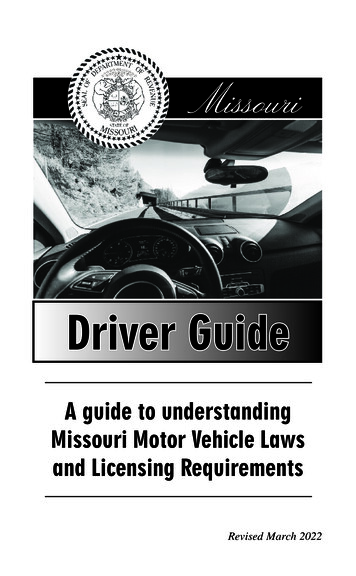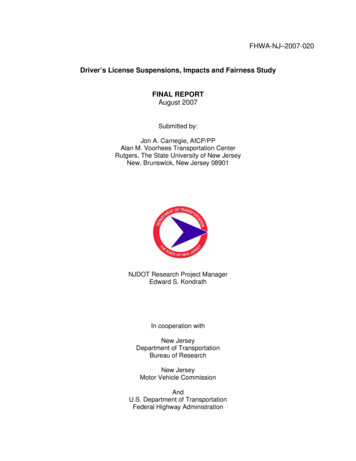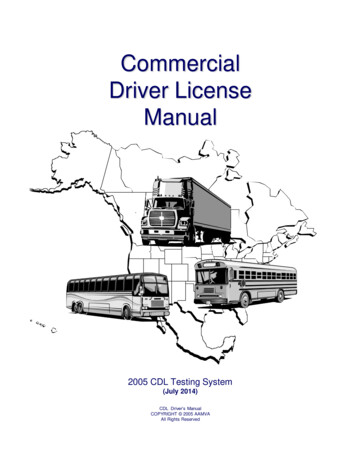
Transcription
CommercialDriver LicenseManual2005 CDL Testing System(July 2014)CDL Driver’s ManualCOPYRIGHT 2005 AAMVAAll Rights Reserved
This material is based upon work supported by the Federal Motor CarrierSafety Administration under Cooperative Agreement No. DTFH61-97-X00017. Any opinions, findings, conclusions or recommendations expressed inthis publication are those of the Author(s) and do not necessarily reflect theview of the Federal Motor Carrier Safety Administration.COPYRIGHT 2005 AAMVA. All rights reservedThis material has been created for and provided to State Driver License Agencies (SDLAs) by AAMVA for the purpose of educating DriverLicense applicants (Commercial or Non-Commercial). Permission to reproduce, use, distribute or sell this material has been granted toSDLAs only. No part of this book may be reproduced or transmitted in any form or by any means, electronic or mechanical, includingphotocopying, recording, or by any information storage and retrieval system without express written permission from the author / publisher.Any unauthorized reprint, use, distribution or sale of this material is prohibited.
Human trafficking is modern-day slavery. Traffickers use force, fraud and coercion to control theirvictims. Any minor engaged in commercial sex is a victim of human trafficking. Trafficking canoccur in many locations, including truck stops, restaurants, rest areas, brothels, strip clubs,private homes, etc. Truckers are the eyes and the ears of our nation’s highways. If you see aminor working any of those areas or suspect pimp control, call the National Hotline and reportyour tip:1-888-3737-888 (US)1-800-222-TIPS (Canada)For law enforcement to open an investigation on your tip, they need “actionable information.”Specific tips helpful when reporting to the hotline would include: Descriptions of cars (make, model, color, license plate number, etc.) and people (height, weight, hair color, eye color, age, etc.)Take a picture if you can.Specific times and dates (When did you see the event in question take place? What day wasit?)Addresses and locations where suspicious activity took placeTrafficking Red Flags to Look for: Lack of knowledge of their community or whereaboutsNot in control of own identification documents (ID/passport)Restricted or controlled communication--not allowed to speak for selfDemeanor: fear, anxiety, depression, submissive, tense, nervousQuestions to Ask: Are you being paid?Are you being watched or followed?Are you free to leave? Come and go as you please?Are you physically or sexually abused? Are you or your family threatened? What is thenature of the threats?Report by Email: Report@PolarisProject.orgWarning: Please do not approach traffickers. Call the hotline, and they will call the FBI and localpolice to deal with them and rescue the victims. Approaching traffickers is not only dangerous foryou and their victims but could lead to problems in the eventual prosecution of traffickers. Go towww.truckersagainsttrafficking.org for more information.Make the Call, SaveLives.
Table of ContentsIntroduction . 1-1Driving Safely . 2-1Transporting Cargo Safely . 3-1Transporting Passengers Safely . 4-1Air Brakes . 5-1Combination Vehicles . 6-1Doubles and Triples . 7-1Tank Vehicles . 8-1Hazardous Materials. 9-1School Bus . 10-1Vehicle Vehicle Inspection . 11-1Basic Vehicle Control Skills Test . 12-1On-Road Driving . 13-1
2005 Model Commercial Driver’s License ManualSection 1INTRODUCTIONtrucking industry. Figure 1.1 helps you determine ifyou need a CDLThis Section Covers Commercial Driver License TestsMedical RequirementsDriver DisqualificationsOther Safety RulesInternational Registration ProgramThere is a federal requirement that each state haveminimum standards for the licensing of commercialdrivers.This manual provides driver license testinginformation for drivers who wish to have acommercial driver license (CDL). This manual doesNOT provide information on all the federal andstate requirements needed before you can drive acommercial motor vehicle (CMV). You may have tocontact your state driver licensing authority foradditional information.You must have a CDL to operate:Any single vehicle with a gross vehicle weightrating (GVWR) of 26,001 pounds or more.A combination vehicle with a gross combinationweight rating (GCWR) of 26,001 or more pounds,provided the GVWR of the vehicle(s) beingtowed is in excess of 10,000 pounds.A vehicle designed to transport 16 or morepassengers (including the driver).Any size vehicle which requires hazardousmaterial placards or is carrying material listedas a select agent or toxin in 42 CFR part 73.Federal regulations through the Department ofHomeland Security require a background checkand fingerprinting for the Hazardous Materialsendorsement. Contact your local department ofdriver licensing for more information.(Your state may have additional definitions ofCMVs.)To get a CDL, you must pass knowledge and skillstests. This manual will help you pass the tests,however, it is not a substitute for a truck drivertraining class or program. Formal training is themost reliable way to learn the many special skillsrequired for safely driving a large commercialvehicle and becoming a professional driver in theSection 1 - IntroductionVersion: July 2013Figure 1.1NOTE:A bus may be Class A, B, or C depending on whetherthe GVWR is over 26,001 pounds or is a combinationvehicle.Page 1-1
2005 Model Commercial Driver’s License Manual1.1 – Commercial Driver License Tests1.1.1 – Knowledge TestsYou will have to take one or more knowledge tests,depending on what class of license and whatendorsements you need. The CDL knowledgetests include:The general knowledge test, taken by allapplicants.The passenger transport test, taken by all busdriver applicants.The air brakes test, which you must take ifyour vehicle has air brakes, including air overhydraulic brakes.The combination vehicles test, which isrequired if you want to drive combinationvehicles.within a defined area. These areas may be markedwith traffic lanes, cones, barriers, or somethingsimilar. The examiner will tell you how each controltest is to be done.On-road Test. You will be tested on your skill tosafely drive your vehicle in a variety of trafficsituations. The situations may include left and rightturns, intersections, railroad crossings, curves, upand down grades, single or multi-lane roads,streets, or highways. The examiner will tell youwhere to drive.Figure 1.2 details which sections of this manualyou should study for each particular class oflicense and for each endorsement.What Sections Should You Study?LICENSEENDORSEMENTTYPE2XXX3XXXXThe School Bust test, required if you want todrive a school bus.6XVehicle Inspection. You will be tested to see ifyou know whether your vehicle is safe to drive.You will be asked to do a Vehicle inspection ofyour vehicle and explain to the examiner what youwould inspect and why.Basic Vehicle Control. You will be tested on yourskill to control the vehicle. You will be asked tomove your vehicle forward, backward, and turn itSection 1 - IntroductionVersion: July 2013XX5*If you pass the required knowledge test(s), you cantake the CDL skills tests. There are three types ofgeneral skills that will be tested: Vehicle inspection,basic vehicle control, and on-road driving. Youmust take these tests in the type of vehicle forwhich you wish to be licensed. Any vehicle thathas components marked or labeled cannot beused for the Vehicle Inspection Test.X4The doubles/triples test, required if you wantto pull double or triple trailers.1.1.2 – Skills TestsXSchool BusXPassengerXTank VehiclesClass CXDouble / TripleClass BSections to StudyThe tank vehicle test, required if you want tohaul any liquid or gaseous materials in a tankor tanks having an individual rated capacity ofmore than 119 gallons and an aggregate ratedcapacity of 1,000 gallons or more that is eitherpermanently or temporarily attached to thevehicle or chassisHazardousMaterialsClass A1The hazardous materials test, required if youwant to haul hazardous materials as defined in49 CFR 383.5.In order to obtain thisendorsement you are also required to pass aTransportation Security Administration (TSA)background check.XXXX7XX8X9XX10X11XXXXX12XXXXX13XXXXX*Study section 5 if you plan to operate vehiclesequipped with air brakes.Figure 1.2 – What to StudyPage 1-2
2005 Model Commercial Driver’s License Manual1.2 – Medical DocumentationRequirementsStarting January 30, 2012 and no later thanJanuary 30, 2014, if you are applying for a CDLPermit; or are renewing, upgrading, addingendorsements to a CDL; or transferring a CDLfrom another state, you are required to provideinformation to your State Driver’s License Agency(SDLA) regarding the type of commercial motorvehicle operation you drive in or expect to drive inwith your CDL. Drivers operating in certain types ofcommerce will be required to submit a currentmedical examiner’s certificate and/or any medicalvariance documents that you have been issued(i.e. Vision, Skills Performance or Diabetic waivers,or other exemptions) to your SDLA to obtain a“certified” medical status as part of your drivingrecord. You must contact your State DriverLicensing Agency (SDLA) to obtain informationregarding the requirement for submitting thesedocuments.If you are required to have a ”certified” medicalstatus and fail to provide and keep up-to-date yourmedical examiner’s certificate you become ”notcertified” and may lose your CDL.For the purpose of complying with the newrequirements for medical certification, it isimportant to know how you are using the CMV.The following information will help you decide howto self-certify:1.2.2 – Inter/Intrastate Commerce: StatusNon-excepted or Excepted?Once you decide whether you will operate ininterstate commerce or intrastate commerce,you must decide whether you will operate (orexpect to operate) in a non-excepted or exceptedstatus. This decision will tell you to which of thefour types of commerce you must self-certify.Interstate Commerce:You operate in excepted interstate commercewhen you drive a CMV in interstate commerce onlyfor the following excepted activities: 1.2.1 – Interstate or Intrastate CommerceDo you, or will you, use a CDL to operate a CMV ininterstate or intrastate commerce? Interstate commerce is when you drive a CMV: From one State to another State or a foreigncountry;Between two places within a State, but duringpart of the trip, the CMV crosses into anotherState or foreign country; orBetween two places within a State, but thecargo or passengers are part of a trip thatbegan or will end in another State or foreigncountry.Intrastate commerce is when you drive a CMVwithin a State and you do not meet any of thedescriptions above for interstate commerce.If you operate in both intrastate commerce andinterstate commerce, you must choose interstatecommerce.Section 1 - IntroductionVersion: July 2013 To transport school children and/or school staffbetween home and school;As Federal, State or local governmentemployees;To transport human corpses or sick or injuredpersons;Fire truck or rescue vehicle drivers duringemergencies and other related activities;Primarily in the transportation of propane winterheating fuel when responding to an emergencycondition requiring immediate response such asdamage to a propane gas system after a stormor flooding;In Response to a pipeline emergency conditionrequiring immediate response such as apipeline leak or rupture;In custom harvesting on a farm or to transportfarm machinery and supplies used in thecustom harvesting operation to and from a farmor to transport custom harvested crops tostorage or market;Beekeeper in the seasonal transportation ofbees;Controlled and operated by a farmer, but is nota combination vehicle (power unit and towedunit), and is used to transport agriculturalproducts, farm machinery or farm supplies (noplacardable hazardous materials) to and from afarm and within 150 air-miles of the farm;As a private motor carrier of passengers fornon-business purposes ; orTo transport migrant workers.If you answered yes to one or more of the aboveactivities as the only operation in which you drive,you operate in excepted interstate commerceand do not need a Federal medical examiner’scertificate.If you answered no to all of the above activities,you operate in non-excepted interstatecommerce and are required to provide a currentmedicalexaminer’scertificate(49CFRPage 1-3
2005 Model Commercial Driver’s License Manual391.45),commonly referred to as a medicalcertificate or DOT card, to your State DriverLicensing Agency (SDLA). Most CDL holders whodrive CMVs in interstate commerce are nonexcepted interstate commerce drivers.If you operate in both excepted e, you must choose non-exceptedinterstate commerce to be qualified to operate inboth types of interstate commerce.Intrastate Commerce:You operate in excepted Intrastate commercewhen you drive a CMV only in intrastate commerceactivities for which your State of licensure hasdetermined do not require you to meet the State’smedical certification requirements. (contact yourSDLA about their requirements).You operate in non-excepted intrastatecommerce when you drive a CMV only inintrastate commerce and are required to meet ements (contact your SDLA about theirrequirements).If you operate in both excepted e, you must choose non-exceptedintrastate commerce.1.2.3 – Self-Certification Statementsmeet the medical requirements for my State;and that I am required to obtain a medicalexaminer’s certificate. Intrastate excepted: I certify that I operate orexpect to operate entirely in intrastatecommerce, that I am not subject to the medicalrequirements for my State; and that I am notrequired to obtain a medical examiner’scertificate.1.3 - CDL Disqualifications1.3.1 – GeneralYou may not drive a commercial motor vehicle ifyou are disqualified for any reason.1.3.2 – Alcohol, Leaving the Scene of anAccident, and Commission of a FelonyIt is illegal to operate a CMV if your blood alcoholconcentration (BAC) is .04% or more. If youoperate a CMV, you shall be deemed to havegiven your consent to alcohol testing.You will lose your CDL for at least one year for afirst offense for:Driving a CMV if your bloodconcentration is .04% or higher.alcoholDriving a CMV under the influence of alcohol.When completing an application for your CDL, youwill be required to check the box next to thestatement that describes your status. The actualstatements on your application may vary fromthose shown below: Interstate non-excepted: I certify that Ioperate or expect to operate in interstatecommerce, that I am subject to and meet theFederal DOT medical card requirements under49 CFR part 391; and that I am required toobtain a medical examiner’s certificate.Refusing to undergo blood alcohol testing.Driving a CMV while under the influence of acontrolled substance.Leaving the scene of an accident involving aCMV.Committing a felony involving the use of a CMV.Driving a CMV when the CDL is suspended.Causing a fatality through negligent operation ofa CMV. Interstate excepted: I certify that I operate orexpect to operate in interstate commerce, butengage exclusively in transportation oroperations excepted under 49 CFR §§390.3(f),391.2, 391.68 or 398.3 from all or parts of thequalification requirements of 49 CFR part 391;and that I am not required to obtain a medicalexaminer’s certificate.You will lose your CDL for at least three years ifthe offense occurs while you are operating a CMVthat is placarded for hazardous materials. Intrastate non-excepted: I certify that Ioperate or expect to operate entirely inintrastate commerce, that I am subject to andYou will be put out-of-service for 24 hours if youhave any detectable amount of alcohol under.04%.Section 1 - IntroductionVersion: July 2013You will lose your CDL for life for a second offense.You will lose your CDL for life if you use a CMV tocommit a felony involving controlled substances.Page 1-4
2005 Model Commercial Driver’s License Manual1.3.3 – Serious Traffic ViolationsSerious traffic violations are excessive speeding(15 mph or more above the posted limit), recklessdriving, improper or erratic lane changes, followinga vehicle too closely, traffic offenses committed ina CMV in connection with fatal traffic accidents,driving a CMV without obtaining a CDL or having aCDL in the driver’s possession, and driving a CMVwithout the proper class of CDL and/orendorsements.You will lose your CDL:For at least 60 days if you have committed twoserious traffic violations within a three-yearperiod involving a CMV.For at least 120 days for three or more serioustraffic violations within a three-year periodinvolving a CMV.1.3.4 – Violation of Out-of-Service OrdersYou will lose your CDL:[For at least 90 days if you have committed yourfirst violation of an out-of-service order.For at least one year if you have committed twoviolations of an out-of-service order in a tenyear period.For at least three years if you have committedthree or more violations of an out-of-serviceorder in a ten-year period].1.3.5 – Railroad-highway Grade CrossingViolationsYou will lose your CDL:For at least 60 days for your first violation.For at least 120 days for your second violationwithin a three-year period.For at least one year for your third violationwithin a three-year period.These violations include violation of a federal, stateor local law or regulation pertaining to one of thefollowing six offenses at a railroad-highway gradecrossing:For drivers who are not required to always stop,failing to stop before reaching the crossing if thetracks are not clear.For drivers who are not required to always stop,failing to slow down and check that the tracksare clear of an approaching train.Section 1 - IntroductionVersion: July 2013Page 1-5
2005 Model Commercial Driver’s License ManualFor drivers who are always required to stop,failing to stop before driving onto the crossing.For all drivers failing to have sufficient space todrive completely through the crossing withoutstopping.For all drivers failing to obey a traffic controldevice or the directions of an enforcementofficial at the crossing.For all drivers failing to negotiate a crossingbecause of insufficient undercarriage clearance.1.3.6 – Hazardous Materials EndorsementBackground Check and DisqualificationsIf you require a hazardous materials endorsementyou will be required to submit your fingerprints andbe subject to a background check.You will be denied or you will lose your hazardousmaterials endorsement if you:Are not a lawful permanent resident of theUnited States.Renounce your United States citizenship.Are wanted or under indictment for certainfelonies.Have a conviction in military or civilian court forcertain felonies.Have been adjudicated as a mental defective orcommitted to a mental institution.Are considered to pose a security threat asdetermined by the Transportation SecurityAdministration.The background check procedures vary fromjurisdiction to jurisdiction.Your licensingagency will provide you with all the informationyou need to complete the required TSAbackground check procedures.1.3.7 – Traffic Violations in Your PersonalVehicleThe Motor Carrier Safety Improvement Act(MCSIA) of 1999 requires a CDL holder to bedisqualified from operating a commercial motorvehicle if the CDL holder has been convicted ofcertain types of moving violations in theirpersonal vehicle.If your privilege to operate your personal vehicle isrevoked, cancelled, or suspended due to violationsof traffic control laws (other than parking violations)you will also lose your CDL driving privileges.Section 1 - IntroductionVersion: July 2013If your privilege to operate your personal vehicle isrevoked, cancelled, or suspended due to alcohol,controlled substance or felony violations, you willlose your CDL for 1 year. If you are convicted of asecond violation in your personal vehicle or CMVyou will lose your CDL for life.If your license to operate your personal vehicle isrevoked, cancelled, or suspended you may notobtain a “hardship” license to operate a CMV.1.4 – Other CDL RulesThere are other federal and state rules that affectdrivers operating CMVs in all states. Among themare:You cannot have more than one license. If youbreak this rule, a court may fine you up to 5,000 or put you in jail and keep your homestate license and return any others.You must notify your employer within 30 days ofconviction for any traffic violations (exceptparking). This is true no matter what type ofvehicle you were driving.You must notify your motor vehicle licensingagency within 30 days if you are convicted inany other jurisdiction of any traffic violation(except parking). This is true no matter whattype of vehicle you were driving.You must notify your employer within twobusiness days if your license is suspended,revoked, or canceled, or if you are disqualifiedfrom driving.You must give your employer information on alldriving jobs you have held for the past 10 years.You must do this when you apply for acommercial driving job.No one can drive a commercial motor vehiclewithout a CDL. A court may fine you up to 5,000 or put you in jail for breaking this rule.If you have a hazardous materials endorsementyou must notify and surrender your hazardousmaterials endorsement to the state that issuedyour CDL within 24 hours of any conviction orindictment in any jurisdiction, civilian or military,for, or found not guilty by reason of insanity of adisqualifying crime listed in 49 CFR 1572.103;who is adjudicated as a mental defective orcommitted to a mental institution as specified in49 CFR 1572.109; or who renounces his or herU. S. citizenship;Your employer may not let you drive acommercial motor vehicle if you have more thanone license or if you’re CDL is suspended orPage 1-6
2005 Model Commercial Driver’s License Manualrevoked. A court may fine the employer up to 5,000 or put him/her in jail for breaking thisrule.All states are connected to one computerizedsystem to share information about CDL drivers.The states will check on drivers' accidentrecords to be sure that drivers do not havemore than one CDL.You are not allowed to hold a mobile telephoneto conduct a voice communication or dial amobile telephone by pressing more than asingle button when driving.You are not allowed to send or read textmessages while driving.You must be properly restrained by a safety beltat all times while operating a commercial motorvehicle. The safety belt design holds the driversecurely behind the wheel during a crash,helping the driver to control the vehicle andreduces the chance of serious injury or death. Ifyou do not wear a safety belt, you are four timesmore likely to be fatally injured if you are thrownfrom the vehicle.Your state may have additional rules that you mustalso obey.1.5 – International Registration PlanInternational Fuel Tax AgreementIf you operate a CDL required vehicle in interstatecommerce, the vehicle, with few exceptions, isrequired to be registered under the InternationalRegistration Plan (IRP) and the International FuelTax Agreement (IFTA). These federally mandatedprograms provide for the equitable collection anddistribution of vehicle license fees and motor fuelstaxes for vehicles traveling throughout the 48contiguous United States and 10 Canadianprovinces.Under the IRP, jurisdictions must registerapportioned vehicles which includes issuinglicense plates and cab cards or proper credentials,calculate, collect and distribute IRP fees, auditcarriers for accuracy of reported distance and feesand enforce IRP requirements.Registrant responsibilities under the Plan includeapplying for IRP registration with base jurisdiction,providing proper documentation for registration,paying appropriate IRP registration fees, properlydisplaying registration credentials, maintainingaccurate distance records, and making recordsavailable for jurisdiction review.Section 1 - IntroductionVersion: July 2013The basic concept behind IFTA is to allow alicensee (motor carrier) to license in a basejurisdiction for the reporting and payment of motorfuel use taxes.Under the IFTA, a licensee is issued one set ofcredentials which will authorize operations throughall IFTA member jurisdictions. The fuel use taxescollected pursuant to the IFTA are calculatedbased on the number of miles (kilometers) traveledand the number of gallons (liters) consumed in themember jurisdictions. The licensee files onequarterly tax return with the base jurisdiction bywhich the licensee will report all operations throughall IFTA member jurisdictions.It is the base jurisdiction's responsibility to remitthe taxes collected to other member jurisdictionsand to represent the other member jurisdictions inthe tax collection process, including theperformance of audits.An IFTA licensee must retain records to supportthe information reported on the IFTA quarterly taxreturnThe IRP registrant and the IFTA licensee maybe the vehicle owner or the vehicle operator.The requirement for acquiring IRP plates for avehicle and IFTA license for a motor carrier isdetermined by the definitions from the IRP Planand the IFTA for Qualified Vehicle and QualifiedMotor Vehicle:For purposes of IRP:A Qualified Vehicle is (except as provided below)any Power Unit that is used orintended for use in two or more MemberJurisdictions and that is used for the transportationof persons for hire or designed, used, ormaintained primarily for the transportation ofproperty, and:(i) has two Axles and a gross Vehicle weight orregistered gross Vehicle weight in(ii) excess of 26,000 pounds (11,793.401kilograms), or(iii) has three or more Axles, regardless of weight,or(iv) is used in combination, when the grossVehicle weight of such combination exceeds26,000 pounds (11,793.401 kilograms).While similar, the Qualified Motor Vehicle in IFTAmeans a motor vehicle used, designed, ormaintained for transportation of persons orproperty and:Page 1-7
2005 Model Commercial Driver’s License Manual1) Having two axles and a gross vehicle weightor registered gross vehicle weight exceeding26,000 pounds or 11,797 kilograms; or2) Is used in combination, when the weight ofsuch combination exceeds 26,000 pounds or11,797 kilograms gross vehicle or registeredgross vehicle weight.Qualified MotorVehicle does not include recreationalvehicles.If the vehicle you operate is registered under IRPand you are a motor carrier licensed under IFTA,then you are required to comply with themandatory record keeping requirements foroperating the vehicle. A universally acceptedmethod of capturing this information is throughthe completion of an Individual Vehicle DistanceRecord (IVDR), sometimes times referred to as aDriver Trip Report. This document reflects thedistance traveled and fuel purchased for avehiclethatoperatesinterstateunderapportioned (IRP) registration and IFTA fuel taxcredentials.Although the actual format of the IVDR may vary, theinformation that is required for proper record keepingdoes not.In order to satisfy the requirements for IndividualVehicle Distance Records, these documents mustinclude the following information:DistancePer Article IV of the IRP Plan(i) Date of trip (starting and ending)(ii) Trip origin and destination – City and Stateor Province(iii) Route(s) of travel(iv) Beginning and ending odometer orhubometer reading of the trip(v) Total distance traveled(vi) In-Jurisdiction distance(vii) Power unit number or vehicle identificationnumber.035 Purchaser's nameAn example of an IVDR that must be completed inits entirety for each trip can be found in Figure 1below. Each individual IVDR should be filled outfor only one vehicle. The rules to follow whentrying to determine how and when to log anodometer reading are the following: At the beginning of the dayWhen leaving the state or provinceAt the end of the trip/dayNot only do the trips need to be logged, but the fuelpurchases need to be documented as well. Youmust obtain a receipt for all fueling and include it withyour completed IVDR.Make sure that any trips that you enter are alwaysfilled out in descending order and that your tripsinclude all state/provinces that you traveled throughon your route.There are different routes that a driver may take,and most of the miles may be within one state orprovince. Whether or not the distance you travel isprimarily in one jurisdiction or spread amongseveral jurisdictions, all information for the tripmust be recorded. This includes the dates, t
2005 Model Commercial Driver's License Manual Section 1 - Introduction Page 1-3 Version: July 2013 1.2 - Medical Documentation Requirements Starting January 30, 2012 and no later than January 30, 2014, if you are applying for a CDL Permit; or are renewing, upgrading, adding endorsements to a CDL; or transferring a CDL
